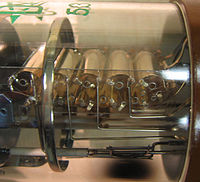
Photo from wikipedia
For antenna modeling and optimization design, high-fidelity full-wave electromagnetic simulation software can generally be used to obtain training samples. However, this process takes a long time. To solve this problem,… Click to show full abstract
For antenna modeling and optimization design, high-fidelity full-wave electromagnetic simulation software can generally be used to obtain training samples. However, this process takes a long time. To solve this problem, a two-stage Gaussian process (GP) considering electromagnetic sensitivity information is proposed. Based on the coarse grid and fine grid of electromagnetic simulation software, the first stage learns the mapping relationships of antenna performance and sensitivity of each parameter, simultaneously. In the second stage, the accurate surrogates are established based on the mapping relationships above obtained. Because the method in this study takes sensitivity information into consideration during the modeling process, it can better reflect the mapping relationship between antenna input and output, which can develop a more accurate surrogate model. The proposed two-stage GP surrogate model considering sensitivity information can significantly reduce the demand of high-fidelity training samples for modeling, and greatly save the simulation time of calling electromagnetic simulation software. Therefore, this method is more suitable for the problems of insufficient electromagnetic simulation samples. The proposed approach is evaluated by modeling and optimization of an inverted F antenna and an ultra-wideband planar monopole antenna. The results show that the method has high modeling accuracy with limited training samples given by high-fidelity electromagnetic simulation, which further verify its effectiveness and efficiency.
Journal Title: IEEE Access
Year Published: 2021
Link to full text (if available)
Share on Social Media: Sign Up to like & get
recommendations!